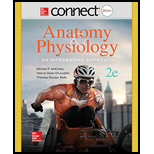
_____ 1. Which bone is formed from intramembranous bone growth?
- a. femur
- b. rib
- c. os coxae (hip bone)
- d. frontal bone
Introduction:
The process of formation and development of bone inside the mesenchyme is called intramembranous ossification. The mesenchyme has an abundance of ground tissue and mesenchymal cells.
Answer to Problem 1DYKB
Correct answer:
The intramembranous ossification leads to the growth of frontal bone. Therefore, option d . is correct.
Explanation of Solution
Reason for the correct statement:
The intramembranous ossification got initiated with the thickening and condensation of the mesenchyme along with a good supply of blood through capillaries. The formation of ossification centers starts in the dense regions of mesenchyme during the development. The spongy and compact bones are formed in layers forming the flat bones. The frontal bone is one of the flat bones of the skull. Hence, the frontal bone is developed from “intramembranous ossification”.
Option d. is given as “frontal bone”.
Hence, option d. is correct.
Reasons for incorrect statements:
Option a. is given as “femur”.
The process, by which most of the bones are produced by hyaline cartilage, is called “endochondral ossification”. The formation and development of femur bone occur by the process of endochondral ossification. Hence, option a. is incorrect.
Option b. is given as “rib”.
The formation and development of rib bone occur by the process of endochondral ossification. Hence, option b. is incorrect.
Option c. is given as “os coxae (hip bone)”.
The formation and development of hip bone occur by the process of endochondral ossification. Hence, option c. is incorrect.
Hence, options a., b., and c. are incorrect.
The flat bones are formed by intramembranous ossification. The frontal bone of skull is one of the flat bones.
Want to see more full solutions like this?
Chapter 7 Solutions
Connect Access Card for Anatomy & Physiology
- Describe the levels of structural hierarchy for the human body, starting with the organismal level and ending with the chemical level. In addition, you should make sure you link each level to the previous level, emphasizing the structural relationships.arrow_forward9 S es Read the section "Investigating Life: In (Extremely) Cold Blood." Then, drag and drop the terms on the left to complete the concept map. Red blood cells Genes Icefishes -have mutated have colorless Oxygen have few lack encode Blood Cellular respiration consists of- contain carries is a Platelets White blood cells carries low amounts of Hemoglobin is necessary for Plasma Protein Reset.arrow_forwardPlating 50 microliters of a sample diluted by a factor of 10-6 produced 91 colonies. What was the originalcell density (CFU/ml) in the sample?arrow_forward
- Every tutor here has got this wrong, don't copy off them.arrow_forwardSuppose that the population from question #1 (data is in table below) is experiencing inbreeding depression (F=.25) (and no longer experiencing natural selection). Calculate the new expected genotype frequencies (f) in this population after one round of inbreeding. Please round to 3 decimal places. Genotype Adh Adh Number of Flies 595 Adh Adh 310 Adhs Adhs 95 Total 1000 fladh Adh- flAdn Adh fAdhs Adharrow_forwardWhich of the following best describes why it is difficult to develop antiviral drugs? Explain why. A. antiviral drugs are very difficult to develop andhave no side effects B. viruses are difficult to target because they usethe host cell’s enzymes and ribosomes tometabolize and replicate C. viruses are too small to be targeted by drugs D. viral infections usually clear up on their ownwith no problemsarrow_forward
- This question has 3 parts (A, B, & C), and is under the subject of Nutrition. Thank you!arrow_forwardThey got this question wrong the 2 previous times I uploaded it here, please make sure it's correvct this time.arrow_forwardThis question has multiple parts (A, B & C), and under the subject of Nutrition. Thank you!arrow_forward
- Calculate the CFU/ml of a urine sample if 138 E. coli colonies were counted on a Nutrient Agar Plate when0.5 mls were plated on the NA plate from a 10-9 dilution tube. You must highlight and express your answerin scientific notatioarrow_forwardDon't copy off the other answer if there is anyarrow_forwardAnswerarrow_forward
 Medical Terminology for Health Professions, Spira...Health & NutritionISBN:9781305634350Author:Ann Ehrlich, Carol L. Schroeder, Laura Ehrlich, Katrina A. SchroederPublisher:Cengage Learning
Medical Terminology for Health Professions, Spira...Health & NutritionISBN:9781305634350Author:Ann Ehrlich, Carol L. Schroeder, Laura Ehrlich, Katrina A. SchroederPublisher:Cengage Learning Comprehensive Medical Assisting: Administrative a...NursingISBN:9781305964792Author:Wilburta Q. Lindh, Carol D. Tamparo, Barbara M. Dahl, Julie Morris, Cindy CorreaPublisher:Cengage LearningBasic Clinical Lab Competencies for Respiratory C...NursingISBN:9781285244662Author:WhitePublisher:Cengage
Comprehensive Medical Assisting: Administrative a...NursingISBN:9781305964792Author:Wilburta Q. Lindh, Carol D. Tamparo, Barbara M. Dahl, Julie Morris, Cindy CorreaPublisher:Cengage LearningBasic Clinical Lab Competencies for Respiratory C...NursingISBN:9781285244662Author:WhitePublisher:Cengage





